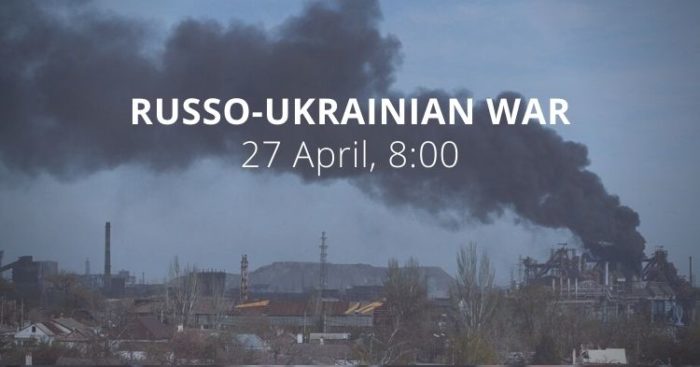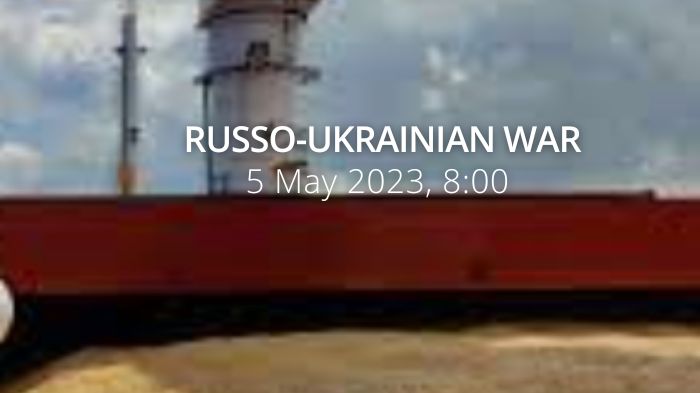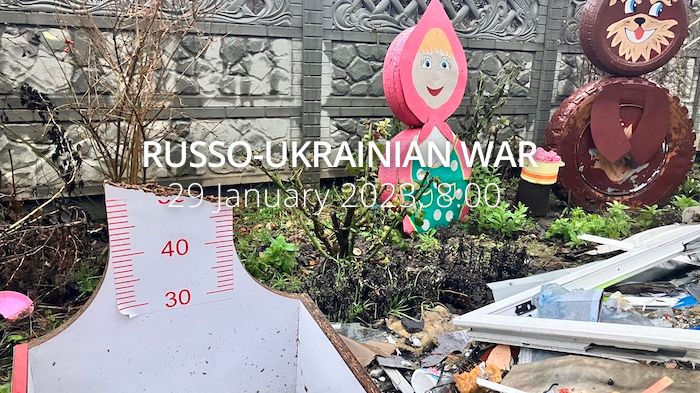Russians killed 403 people in the Mykolaiv Oblast since the beginning of the war but no plans for mandatory evacuation. Russian forces made marginal gains southeast of Bakhmut and continued offensive operations to the northeast and southeast of Bakhmut. They made incremental advances around Avdiivka and are continuing attempts to push southwest of Avdiivka. Unconfirmed social media reports suggest that Iran may have sent the first batch of drones to Russia and sent pilots and maintenance personnel to train on the Russian Su-35, potentially suggesting that Iran may seek to use recent aviation agreements to facilitate the acquisition of Russian combat aircraft, ISW reports. Russia says the United States is directly involved in the Ukraine war. The office of the President accuses some EU countries, particularly Germany of holding back crucially important €8 billion in macro-financial assistance to Ukraine. New US sanctions.
Daily overview — Summary report, August 3
A map of the approximate situation on the ground in Ukraine as of 00:00 UTC 03/08/22.
There have been no notable changes to control since the last update. pic.twitter.com/TjSVi5nyfT
— War Mapper (@War_Mapper) August 3, 2022
According to military expert Stanislav Haider, as of August 3,
Kharkiv Oblast. All the Russian assaults failed, particularly in the directions of Kochubeivka-Dementiivka, Ternova-Bairak. Once again, Russians reinforced their troops with 1-2 battalion tactical groups (BTGs) worth of the forced conscripts of "LDNR" - parts of Luhansk and Donetsk oblasts occupied by Russia since 2014. Russian troops that used to be there are already deployed in the south.
Kherson Oblast. Near Dariivka, the Russians installed another small pontoon bridge and "accidentally blew up their own train with equipment and ammunition." The number of battles is increasing in the area. Yesterday, the former Head of the Kherson Regional State Administration, Dmytro Butriy, said that 7 more settlements were liberated in the region.
Zaporizhzhia Oblast. Russian troops are also strengthening themselves here by 1-2 BTGs. Ukrainian troops continue to slowly advance in the area of Nesterianka, Dorozhnianka, Shcherbaky. In other areas, the counter-battery fire continues.
The work of the Ukrainian artillery:
- Russian ammunition warehouses: Beryslav district, Chornobaivka district (Kherson Oblast);
- an ammo depot and a Russian base: the airport near Chornobaivka;
- an oil depot: Makiivka, Donetsk Oblast.
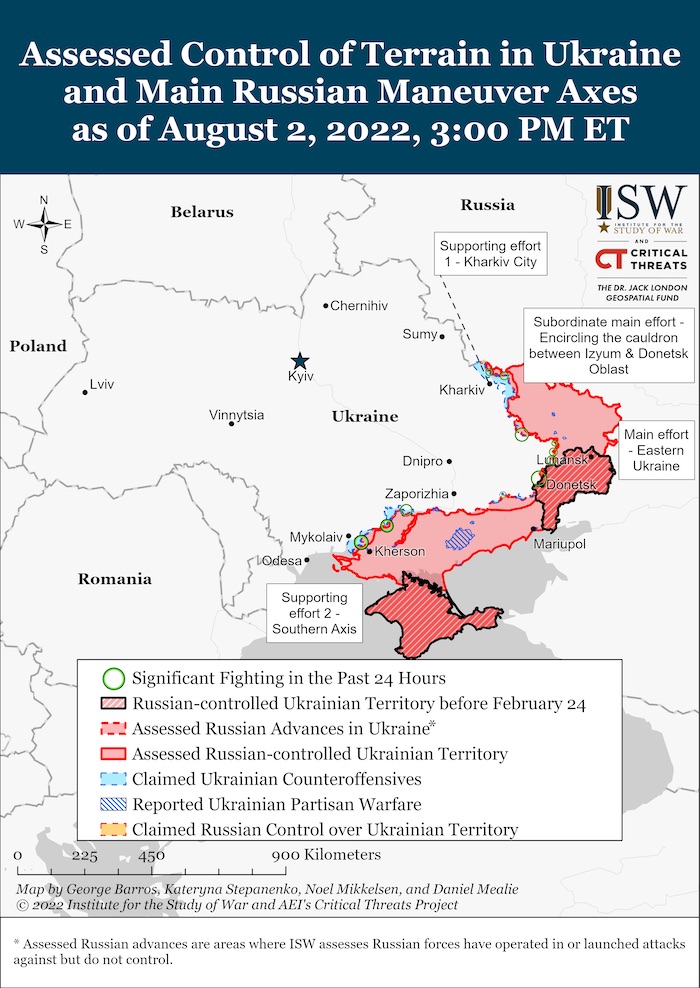
The General Staff’s operational update regarding the Russian invasion as of 06.00 am, August 3, 2022 is in the dropdown menu below.
“[In the Volyn and Polissya directions, the composition, condition and position of the units of the armed forces of the Republic of Belarus in the Brest and Gomel regions remain without significant changes.] Communications training of the General Staff of the Armed Forces of the Republic of Belarus was held. The occupiers continue to use the territory of the Republic of Belarus to transfer sabotage and intelligence groups to the territory of Ukraine.
- [According to available information, the Republic of Belarus continues to supply certain types of ammunition for the needs of the armed forces of the russian federation.]
- [The threat of missile strikes from the territory of the Republic of Belarus remains.]
In the Siversky direction, Russian forces fired at the positions of our troops from artillery. Conducts aerial reconnaissance in the border areas of Chernihiv and Sumy oblasts. The work of Russian means of radio-electronic warfare is noted.
[In the Slobozhansky direction, Russian forces continue to conduct hostilities to hold the occupied lines and prevent the Defense Forces from creating favourable conditions for resuming the offensive. Russian forces take measures to replenish losses of personnel, as well as weapons and military equipment.]
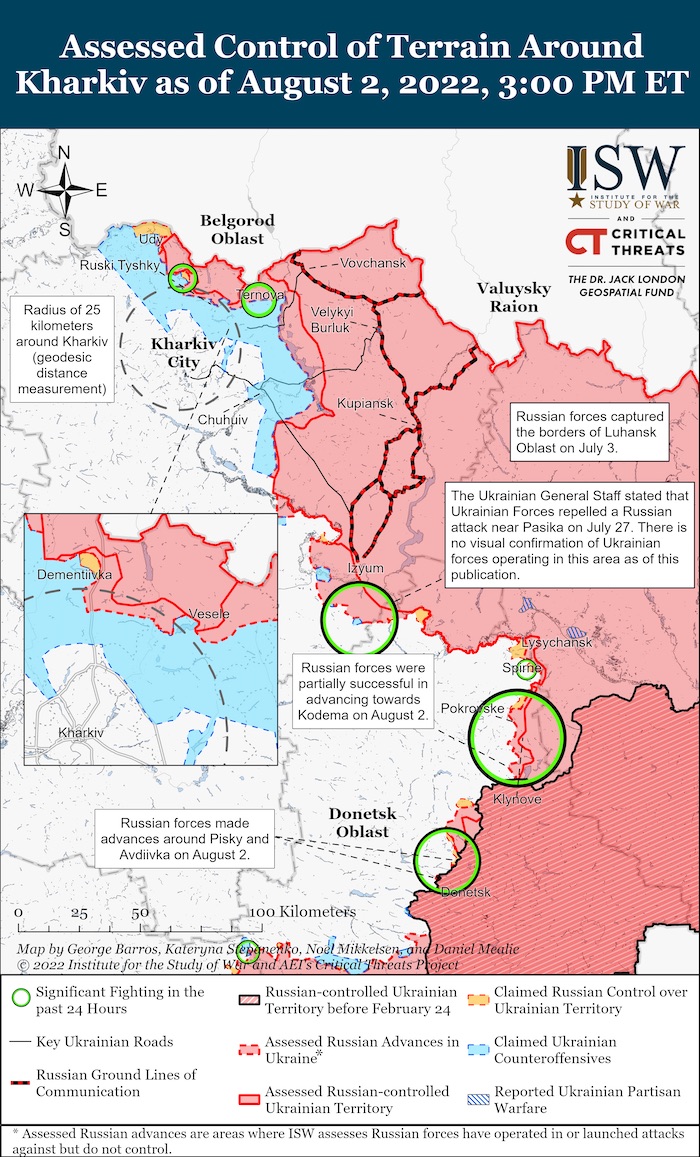
- In the Kharkiv direction, the areas of the settlements of Kharkiv, Prudyanka, Pytomnyk, Ruski Tyshki, Nova Mykolaivka, Rubizhne, Pishchane, Borshcheva, Zamulivka, Lebyazhe, Korobochkyne, Bazaliivka and Basove were shelled. [Yesterday, Russian forces shelled the areas of the settlements of Kharkiv, Chuhuiv, Dementiivka, Protopopivka, Husarivka, Chepil, Pytomnyk, Cherkaski Tyshki, Petrivka, Rtyshchivka, Staryy Saltiv, Skrypali, Sosnivka, Tsirkuny and Svitlichne from tanks, artillery and MLRS. Made an airstrike near Verkhniy Saltiv.]
- The occupiers made an advance in the direction of Kochubeyivka - Dementiyivka, but were repulsed and retreated.
- [The occupiers failed and retreated after an attempt to improve the tactical position in the direction of Ternov - Bayrak.]
- In the Sloviansk direction, shelling from artillery and MLRS was recorded near Nova Dmytrivka, Bohorodychne, Chepil, Karnaukhivka, Dovhenky, Barvinkove, Shnurky, Husarivka, and Dmytrivka. [Yesterday, Russian forces fired from artillery and MLRS in the areas of Kurulka, Hrushuvakha, Dibrivne, Adamivka, Dolyna, Krasnopillya, Mazanivka, Velyka Komyshuvakha, Vasylivka Persha and Khrestyshche settlements. Made an airstrike near Dibrivne.]
- Russian forces tried to conduct reconnaissance south of Mazanivka, the occupiers were detected and neutralized.
- [The activity of reconnaissance groups near Dovhenke and Dolyna was detected and the groups withdrew.]
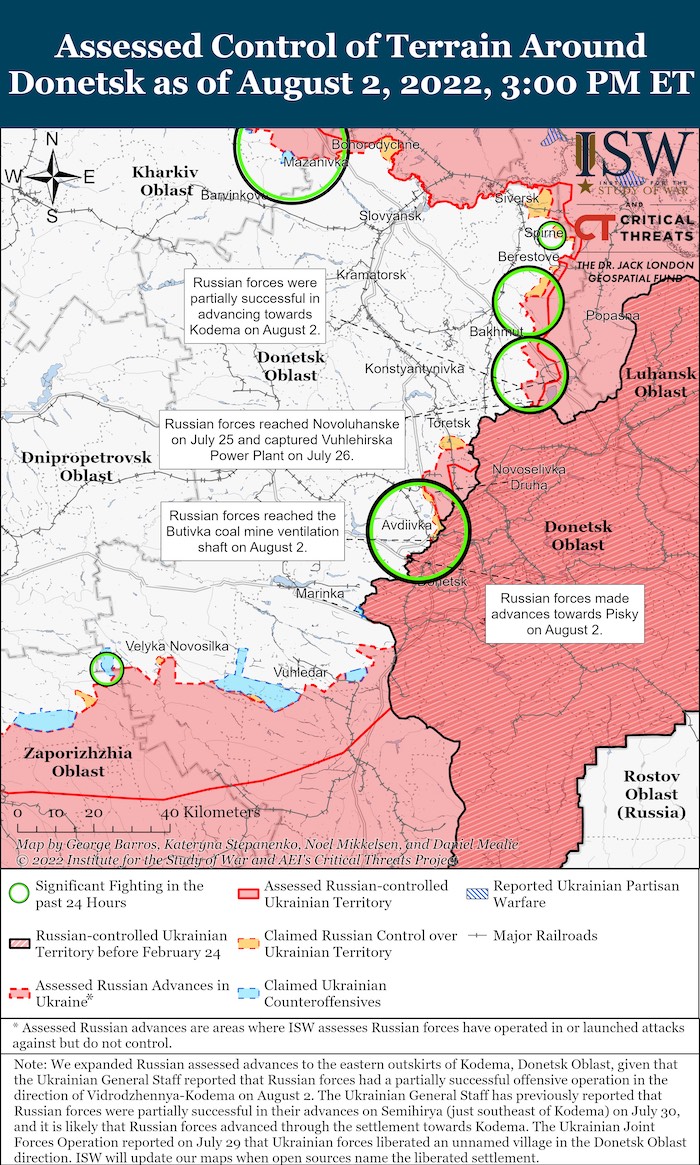
[In the Donetsk direction, Russian forces are concentrating their efforts on conducting an offensive in the Bakhmut and Avdiivka directions. By systematic fire damage, Russian forces are trying to restrain the actions of our troops and prevent them from moving in threatening directions.]
- [In the Kramatorsk direction, shelling was recorded yesterday near Siversk, Serebryanka, Verkhnokamyansk, Zvanivka, and Donetsk. Russian forces launched an airstrike near Serebryanka. Conducted aerial reconnaissance of the UAV near Kryva Luka.]
- In the Siversk direction, Russian forces fired from artillery and MLRS, as well as tanks near Siversk, Serebryanka, and Hryhorivka. Conducted aerial reconnaissance of the UAVs near Nykyforivka and Tetyanivka.
- In the Bakhmut direction, in order to dislodge our units from the occupied lines, artillery shelling was conducted in the areas of Kodema, Semyhirya, Travneve, Vyimka, Berestove, Bakhmutske and Opytne settlements. Carried out airstrikes near Semihirya and Bilohorivka. [Yesterday, artillery shelling was recorded in the areas of Yakovlivka, Soledar, Bakhmut, Zaytsevo, Pokrovsky, Vesele, Kurdyumivka and Zalizne. Russian forces increased the intensity of aviation in the indicated direction and carried out airstrikes near Yakovlivka, Pokrovske, Soledar, Bakhmut and Kodema.]
- [All attempts of Russian forces to advance in the directions of Roty - Vershyna, Volodymyrivka - Yakovlivka, Klynove - Zaitseve and Pokrovske - Bakhmut were yesterday successfully repulsed. The invaders retreated with losses.]
- Russian forces launched an offensive in the area of the western outskirts of Berestove, were unsuccessful, and retreated. The situation is the same in the directions Volodymyrivka – Yakovlivka and Semihirya – Kodema.
- Fighting continues in the Volodymyrivka - Soledar and Pokrovske - Bakhmut
- Ukrainian soldiers inflicted powerful fire damage on the directions of Vidrodzhennya – Kodem and Dolomytne – Semihyrya and forced the occupiers to withdraw. [Some units of Russian forces had yesterday partial success in the direction of Vidrodzhenya - Kodema.]
- In the Avdiivka direction, Russian forces shelled the Avdiivka area. Tried to improve the tactical position, unsuccessfully, retreated with losses. [Yesterday, Russian forces shelled the areas of Avdiivka, Netaylove and New York settlements. Carried out airstrikes near Avdiivka and Novobakhmutivka.]
- [The occupiers carried out assaults in the direction of Mineralne - Avdiivka, but they did not succeed, they retreated. Russian forces have partial success in the Donetsk-Pisky
- [Russian forces tried to advance in the direction of Novoluhanske - Ivano-Daryivka. It [received a decisive rebuff from our soldiers and retreated.]
- On the Novopavlivske and Zaporizhzhia directions, shelling was recorded near Kostiantynivka, Novosilky, Velyka Novosilka, Charivne, Mala Tokmachka, Novopole, Yurkivka, and Hulyaipole. [Yesterday, shelling was recorded near Novomykhailivka, Pavlivka, Zaliznychne, Kamianske, Poltavka, Chervone, Novoandriivka, and Mariinka. Russian forces also launched an airstrike near Mariinka. Conducted aerial reconnaissance of the UAV in the area of ]
- To counteract the technical means of intelligence, Russian forces deploy means of radio-electronic warfare.
In the Pivdenny Buh direction, in order to hinder the actions of our troops, Russian forces are shelling positions from tanks, artillery and MLRS in the areas of the settlements of Potyomkyne, Topolyne, Knyazivka, Velyka Kostromka, Apostolove, Stepova Dolyna, Posad Pokrovske, Novohrihorivka, Luparevo, Lymany, Kobzartsi, Shyroke, Kvitneve and Bilohirka. Used aviation to attack the area of the Plotnytske tract. [Trying to regain lost position.]
- [Yesterday, the areas of Mykolaiv, Trudolyubivka, Osokorivka, Ivanivka, Olenivka, Zorya, Blagodatne, Pryshyb, Tokareve, Novovorontsovka, Bila Krynytsia, Andriivka, Vesely Kut, and Yavkine were shelled from tanks, artillery, and MLRS. Made an airstrike near Zorya.]
- It conducts aerial reconnaissance to clarify the position of our troops, adjust fire and control the camouflage of its units.
- It continues to take measures to ensure the protection of bridge crossings across the Dnipro River.
In the waters of the Black Sea, there are two warships with Kalibr cruise missile carriers ready to use.
Russian aviation group conducts systematic combat operations in order to support the actions of ground groups. Efforts are focused on hitting military facilities in the Donetsk direction. Due to bad weather conditions, the intensity of aviation flights is reduced.
Ukrainian missile and artillery units continue to fire at strong points, manpower concentrations, and enemy logistical support bases.
Due to the low level of staffing of the tank regiment of the reserve, the equipment of the military unit, which was moved to the Zaporizhzhia direction at the end of May of this year, was handed over for additional staffing of the tank battalions that are part of the 58th Combined Arms Army of the Southern Military District.
[Russian forces continue to suffer losses in manpower and equipment. Among the Russian occupiers, there is an increase in alcohol abuse, as a result - disobedience to officers and inter-ethnic conflicts.]”
Military Updates
Ukraine's commander in chief Zaluzhnyi talked with Chairman of Chiefs of Staff Gen. Milley & Supreme Commander Europe Gen. Cavoli:
"I value their support... assessment of our activities & plans, thankful to the entire American Nation for the assistance." https://t.co/JAzFKM7fYF pic.twitter.com/OkMA0Q4SFc
— Euromaidan Press (@EuromaidanPress) August 2, 2022
Seven more localities have been de-occupied in the Kherson region, now totalling 53
, Ukrinform reports. "As of today, the liberation of 53 localities is officially confirmed. We provide this information only when it is agreed with the General Staff. Before the complete liberation, the service personnel carry out certain demining activities," Dmytro Butriy, Head of the Kherson Regional Military Administration, said. He emphasized that practically the entire de-occupied territory constantly came under enemy fire. According to him, local residents are not recommended to return to these localities.”
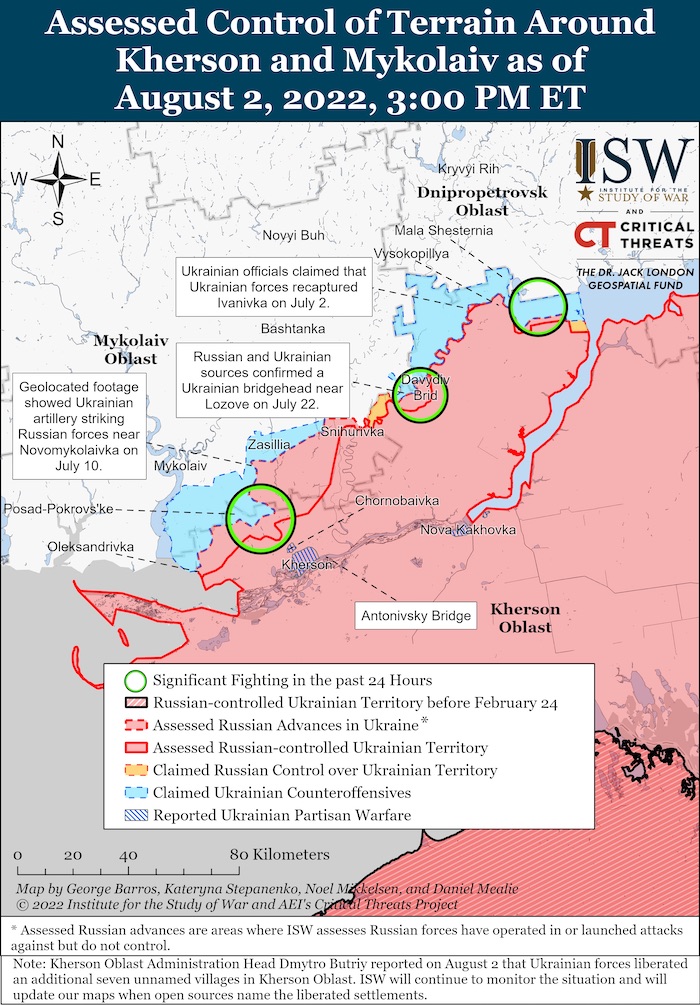
Seven out of eight Russian missiles from the Caspian Sea region were shot down, the General Staff of Ukraine reports. “On August 2, around 5 p.m., the occupiers launched a missile attack from the Caspian Sea region. Russian forces used Tu-95 (Tu-160) strategic bombers. In total, eight X-101 (X-555) type cruise missiles were launched over the territory of Ukraine in the direction of the central, southern and western regions of Ukraine.
Seven of the eight missiles were shot down by the air defence of the Air Force of the Armed Forces of Ukraine. Six missiles were eliminated by anti-aircraft missile forces and one was shot down by an Air Force fighter jet. Unfortunately, there was one hit in the Lviv region - an anti-aircraft missile complex was hit. Damages are being determined.”
Pentagon refutes Russian claims of destroying HIMARS launchers in Ukraine, Ukrinform reports, citing Reuters. “The Pentagon on Tuesday denied Russian claims that the country had destroyed six US-made HIMARS missile systems since the beginning of the conflict in Ukraine. We are aware of these latest claims by Minister Shoigu and they are again patently false, Todd Breasseale, the Pentagon's acting spokesman, said.”
According to British Defence Intelligence, (last 48 hours):
- As a result of a Ukrainian strike against a Russian ammunition train in Kherson oblast, southern Ukraine, it is highly unlikely the rail link connecting Kherson with Crimea remains operational. Russian forces are likely to repair the railway line within a few days, although it will remain a vulnerability for Russian forces and their logistical resupply route from Crimea into Kherson.
- Russia has promoted the ferry crossing recently established to replace the damaged Antonovsky Bridge over the Dnipro River in Kherson for civilian use. However, Russian military forces will almost certainly utilise it for troop movements and logistical resupply.
- It is likely we will see an increase in civilians attempting to flee Kherson and the surrounding area as hostilities continue and food shortages worsen. This will create pressure on transport nodes and routes, likely resulting in measures to control movement being implemented.
- The Sierra Leone-flagged cargo ship RAZONI left the Ukrainian Black Sea port of Odesa on 1 August, headed to the port of Tripoli in Lebanon loaded with 26,000 tonnes of Ukrainian grain. This marks the first grain shipment from a Ukrainian port since the invasion began, enabled by an agreement on a grain export transit corridor between Ukraine, Türkiye, the UN, and Russia on 22 July.
- The reported strike on Russian Black Sea Fleet headquarters in Sevastopol on Navy Day is the latest setback for the Black Sea Fleet in the five-month-old war against Ukraine, which included the loss of its flagship, the cruiser MOSKVA, in April 2022.
- Following the reports of cancelled parades, it is unlikely that the Black Sea Fleet can manage high profile public events alongside its wartime activities.
Losses of the Russian army
As of Wednesday 3 August, the approximate losses of weapons and military equipment of the Russian Armed Forces from the beginning of the war to the present day:
- Personnel – more than 41350 (+180),
- Tanks – 1774 (+6),
- Armoured combat vehicles – 4022 (+8),
- Artillery systems – 939 (+3),
- Multiple rocket launchers –MLRS - 259 (+0),
- Air defence means – 118 (+1),
- Aircraft - 223 (+0),
- Helicopters - 191 (+0),
- Automotive technology and fuel tanks – 2922 (+8),
- Vessels/boats - 15 (+0),
- UAV operational and tactical level – 740 (+1),
- Special equipment – 83 (+1),
- Mobile SRBM system – 4 (+0),
- Cruise missiles – 180 (+6)
Russian enemy suffered the greatest losses (of the last day) in the Bakhmut and Donetsk directions.
The number of wounded Russian soldiers in the Kherson region growing, Ukrinform reports, citing Yurii Sobolevskyi, the first deputy chairman of the Kherson Regional Council. "The orcs in the Kherson region are suffering significant losses. The number of those wounded is constantly growing, which led to the deployment of a military hospital at a hospital in Beryslav, Sobolevskyi said. According to him, about 40 doctors, brought from Russia, tried to occupy houses abandoned by their owners, but the locals drove them out. Now the military doctors are forced to live in a hospital building.”
⚰️russia's combat losses in Ukraine as of August 3
▪ 41350 killed soldiers (+180)
▪ 4022 APV (+8)
▪ 1774 tanks (+6)
▪ 939 artillery systems (+3)
▪ 223 aircraft and 191 helicopters
▪ 15 boats and cutters#StopRussia #StandwithUkraine pic.twitter.com/J15oNIoJxh— VoxUkraine (@voxukraine) August 3, 2022
Humanitarian
Russian troops destroyed an orphanage in Mykolayivka, Donetsk Oblast, by shelling.
A body of one killed man was found after rescuers dismantled 60 tonnes of the rubble. https://t.co/KoNI2D33L3 pic.twitter.com/MPnc1dKaGp
— Euromaidan Press (@EuromaidanPress) August 2, 2022
Pro-Kremlin puppet leader Pushylin states that more than 3,500 Ukrainian prisoners of war are being held in the "DNR", Ukrainska Pravda reports, citing RT. “Denys Pushylin, the Pro-Kremlin puppet leader of the self-proclaimed "DNR" [Donetsk People’s Republic], has claimed that militants in "DNR" are detaining more than 3,500 Ukrainian prisoners of war.”
Two-thirds of Donetsk Oblast residents have been evacuated; 250,000 residents remain, Ukrainska Pravda reports. “Two-thirds of the residents of Donetsk Oblast have been evacuated since February 24. Only the people who chose to stay to the bitter end remain in the oblast, [according to the head of Donetsk Oblast Military Administration, Pavlo Kyrylenko.]”
Occupiers killed 403 people in the Mykolaiv region, but no plans for mandatory evacuation – Oblast Military Administration, Ukrainska Pravda reports. “As a result of the Russian shelling of Mykolaiv Oblast since the beginning of the war, 403 people have been killed and more than 1000 injured, but no mandatory evacuation of the civilian population from the region is currently being planned, the head of Oblast Military Administration, Vitalii Kim, said a briefing.”
As Russia Threatens Europe’s Energy, Ukraine Braces for a Hard Winter, The New York Times reports. “As President Vladimir V. Putin slashes natural gas flows to Ukraine’s European allies, the government in Kyiv has accused Russia of also stepping up the destruction of critical infrastructure that provides heat, water and electricity to millions of homes, businesses and factories.
All cities are preparing for a hard winter, said Andriy Sadovyi, the mayor of Lviv, where Russian rockets knocked out three electrical substations in April, temporarily cutting power to neighborhoods. […] The urgency escalated after Russia again curtailed gas supplies
to Europe last week, leading the European Union to announce that it will reduce imports of Russian gas so as not to be held hostage. Russia turned off the gas taps to Latvia on Saturday, after the government there announced additional military assistance for Ukraine, the latest in a string of European countries to do so.
Ukraine buys its natural gas from European neighbors, so the restriction of deliveries to Europe threatens its access to energy, too. Ukrainians frequently say they hope to defeat Russia by the time the cold weather arrives in October. But the leadership is also girding for the possibility of a drawn-out conflict in which Russia turns up the pressure by methodically strangling Ukrainians’ ability to keep warm.
Hundreds of thousands of civilians living in the Donetsk region of eastern Ukraine were ordered to evacuate this past weekend after months of relentless Russian bombardment destroyed the infrastructure needed to deliver heat and electricity.
We understand that the Russians may continue targeting critical energy infrastructure before and during the winter, said Oleksiy Chernyshov, Ukraine’s minister for communities and territories development, in an interview. They’ve demolished central heating stations in big cities, and physical devastation is still happening nationwide, he said. We are working to repair damage, but it doesn’t mean we won’t have more.
Far from Ukraine’s embattled southeastern front, the campaign is being waged in forests and in steel forges, at gas storage sites and electrical stations, and even in basement boiler rooms, as the government mobilizes regions to activate a blueprint for amassing fuel and shelter.”
https://twitter.com/EuromaidanPress/status/1554571629933494281
️️Environmental
The first ship carrying grain from Ukraine’s Odesa port has reached the Turkish coast.
The Sierra Leone-flagged Razoni is due to be inspected by a team that includes Russian and Ukrainian officials before delivering its 26,000 tons of maize to Lebanon. https://t.co/7YwqAxQnq0 pic.twitter.com/1kszE3H12V
— Euromaidan Press (@EuromaidanPress) August 2, 2022
Türkiye expects daily departures from Ukraine after the first grain ship sails, Reuters reports. “Türkiye expects roughly one grain ship to leave Ukrainian ports each day as long as an agreement that ensures safe passage holds, a senior Turkish official said on Tuesday after the first wartime vessel safely departed Odesa on Monday.
The first ship, Razoni, carrying 26,527 tonnes of corn to Lebanon, was crossing the western Black Sea off Romania's Danube Delta at 0714 GMT, nearly halfway to Turkish waters, where it will be inspected on Wednesday, Refinitiv Eikon data showed.”
Fifteen vessels with Ukrainian grain ready to depart, two more next in line – Vysotskyi, Ukrinform reports, citing the press service of the Ukrainian Agrarian Policy and Food. “On August 1, 2022, the vessel Razoni, flying the flag of Sierra Leone, left Odesa Port with 26,000 tonnes of Ukrainian-produced corn. It is the first ship to have departed from the Ukrainian port in the Black Sea since the Russian invasion started.
Today about 15 vessels have been confirmed to be technically ready, and two more are being finalized. Then, there will be two-way traffic, including the approach of vessels for loading, the ministry noted. Such vessels are primarily intended to transport grain crops (corn, wheat, barley), and later oilseeds and processed products. Each vessel can carry from 10,000 to 60,000 tonnes.”
Russia is losing its energy influence on the EU market, Ukraine Business News reports. A European Union ban on importing coal from the Russian Federation came into effect on August 1. Thus, the Russian Federation is losing its energy influence on the European market, said Ukrainian Energy Minister Herman Galushchenko. According to the minister, Over the past five months, the EU has imported 40% more coal from South Africa than last year. Moreover, from January to May of this year, almost twice as many EU countries bought coal from Kazakhstan than in 2021. According to the minister, Ukraine ridded itself of its Russian coal dependence prior to the last heating season. In particular, in November 2021, Ukraine started diversifying its coal supply and successfully implemented it.
Legal
Russia's supreme court designates Ukraine's Azov Regiment a 'terrorist' group, Reuters reports. “Russia's top court on Tuesday designated Ukraine's Azov Regiment as a terrorist group, a Reuters correspondent in the courtroom said, paving the way for captured soldiers to be tried under stringent anti-terror laws and be jailed for up to 20 years. Last week, Russia's embassy in London said in a Twitter post that captive Azov personnel should be hung and that they deserve a humiliating death".
358 children were killed, and 693 children injured, the Office of the Prosecutor General of Ukraine reports as of August 3. 2,207 educational establishments are damaged as a result of shelling and bombings, 226 of them are destroyed fully. 26,465 crimes of aggression and war crimes and 12,482 crimes against national security were registered.
Support
The US has expanded the list of Russians subjected to sanctions.
The list now includes Putin's mistress Alina Kabaeva and several occupational authorities, including self-proclaimed "mayor" of Mariupol Ivashchenko & Kherson "governor" Stremousov https://t.co/XkgcB6AxFT
— Euromaidan Press (@EuromaidanPress) August 2, 2022
Zelensky calls on Stoltenberg to provide heavy weapons for counteroffensive as soon as possible, Ukrinfom reports, citing the press service of the Head of State. “In a phone conversation with NATO Secretary General Jens Stoltenberg, President Volodymyr Zelensky stated the need for Ukraine to quickly obtain more heavy weapons in order to successfully repulse Russian attacks and launch a counteroffensive.
In addition, Zelensky emphasized the importance of receiving non-lethal military aid from the Alliance as soon as possible within the framework of the comprehensive package approved at the Madrid NATO Summit. He emphasized the importance of ensuring the full financing of this assistance.
The parties also discussed the status of processing Ukraine's requests to NATO regarding aid in humanitarian demining and expressed hope for the acceleration of the supply of the necessary equipment.»
The Armed Forces of Ukraine received four more M142 HIMARS High Mobility Artillery Rocket Systems as part of the United States military assistance program, the General Staff of Ukraine reports. Minister of Defence of Ukraine Oleksii Reznikov informed on #Twitter
: «4 additional HIMARS have arrived in Ukraine. I’m grateful to President Joe Biden, the United States Secretary of Defense Lloyd Austin III US Department of Defense (DoD) and the People of the United States for strengthening the UA Army. We have proven to be smart operators of this weapon. The sound of the HIMARS volley has become a top hit of this summer at the front lines!»
The US will send another $550 million in arms to Ukraine, The New York Times reports. “The White House announced on Monday that the United States would send another $550 million in arms to Ukraine to help it fend off Russian invaders, increasing the total American investment in warfighting there to more than $8 billion since the invasion began in February.
Mr. Kirby said that Secretary of State Antony J. Blinken; Gen. Mark A. Milley, the chairman of the Joint Chiefs of Staff; and Jake Sullivan, the national security adviser, had informed their Ukrainian counterparts about the new weapons shipments on Monday. Mr. Blinken said in a statement that he was authorizing a drawdown of arms and equipment from Department of Defense inventories for Ukraine’s self-defense.
The arms transfer will include ammunition for the High Mobility Artillery Rocket Systems, or HIMARS, rocket launchers that have been used to destroy Russian command posts and ammunition depots as well as for 155-millimeter howitzers already in use by Ukrainian troops, Mr. Kirby said.
US support in the targeting of Russian fuel and ammunition depots and battlefield headquarters, according to Telegraph and UK5News. “Asked how the US-provided Himars multiple launch rocket systems have targeted Russian fuel and ammunition depots and battlefield headquarters in eastern Ukraine so precisely, Maj Gen Skibitsky said "in this case in particular, we use real-time information".
US officials are not providing direct targeting information, which would potentially undermine their case for not being direct participants in the war. However, he suggested there was a level of consultation between intelligence officials of both countries prior to launching missiles that would allow Washington to stop attacks if they were unhappy with the intended target.
I can't tell you whether we are directly tasking British and American satellites, but we have very good satellite imagery, he told The Telegraph. We have very good cooperation with our partners in the UK in this field. We have very good communication with all the sister intelligence agencies."
New US sanctions - Imposing additional costs on Russia for its continued war against Ukraine, a press release from the US Department of State reads. The Department of State is announcing a series of actions to promote accountability for actions by Russian Federation officials and others that implicate violations of Ukraine’s sovereignty including visa restrictions on 924 individuals, the designation of seven individuals and one entity as Putin enablers, and sanctions on 24 Russian defence and technology companies to further isolate Russia’s defence and high-technology industries and limit their contributions to Moscow's war machine.
Ukraine receives €1B in macro-financial assistance from the EU, Ukrinform reports. "We have very positive news today. Ukraine received EUR 1 billion out of 9 billion macro-financial assistance approved by all the leaders of the EU member states. The European Council confirmed this decision twice. We expect to receive another 8 billion euros, Ihor Zhovkva, Deputy Head of the President's Office, said at a briefing.”
Office of the President accuses "some EU countries, particularly Germany" of holding back €8 billion in macro-financial assistance to Ukraine, Ukrainska Pravda reports, citing European Pravda. "There was a very positive piece of news today: Ukraine has received €1 billion out of €9 billion of macro-financial assistance which has been approved by the leaders of all member states of the European Union," stated [Ihor Zhovkva, the diplomatic advisor to the President of Ukraine and deputy head of the Office of the President].
"We are expecting to receive €8 billion more. Unfortunately, some countries in the European Union, particularly Germany, have so far blocked the examination of this issue, and the President of Ukraine is conducting active talks with his partners," he added.
On Monday Arianna Podestà, spokesperson for the European Commission, claimed that the EU currently does not have the funds to provide the second tranche, worth €8 billion. She stated that the current multi-year budget does not allow sufficient funds to create a financial airbag. The EU was therefore considering alternative solutions, particularly using guarantees provided by the member states.
It was subsequently revealed that during a talk with Emmanuel Macron on Monday, Volodymyr Zelenskyy asked for help to unblock the macro-financial assistance due to be provided by the EU.”
Belgium freezes 50 bn euros of Russian assets; in total, $330 bn frozen worldwide
New Developments
A private flight from Nice, France, to Moscow reportedly flew today despite sanctions, Ukrainian journalist Mykhailo Tkach wrote.
It is not yet known what was the purpose of the flight. https://t.co/E6PVi8KxED pic.twitter.com/c4RUJWhhl3
— Euromaidan Press (@EuromaidanPress) August 2, 2022
- S. Senate to vote Wednesday on Finland, Sweden NATO accession, Reuters reports. “The US Senate will hold votes on Wednesday on approving Finland's and Sweden's accession into NATO, Majority Leader Chuck Schumer announced on Tuesday. The debate, Schumer said, will begin at 1:30 p.m. EDT (1730 GMT).”
- Russia says the United States is directly involved in the Ukraine war, Reuters “Russia on Tuesday said that the United States, the world's top military power, was directly involved in the conflict in Ukraine because US spies were approving and coordinating Ukrainian missile strikes on Russian forces.”
- Medvedev: Georgia should be entirely occupied by Russia, Ukrainska Pravda “The deputy chairman of the Security Council of the Russian Federation, Dmitry Medvedev, reflected on the restoration of Russia's borders, saying that Georgia should be completely occupied, because it did not exist before".
- Shoigu says occupation of the Donetsk Oblast continues "according to plan", Ukrainska Pravda reports, citing RIA Novosti. “Russian Defence Minister Sergei Shoigu said that the Russian occupation of the Donetsk Oblast is continuing according to plan.”
- Former German chancellor Schroeder says the Ukraine grain deal may pave way for a ceasefire, Reuters “The deal between Moscow and Kyiv to unblock Ukrainian grain exports may offer a way forward to a possible ceasefire in the five-month conflict, said former German chancellor Gerhard Schroeder, a friend of Russian President Vladimir Putin.”
Hans Petter Midttun: It will not pave way for a ceasefire. Ukraine will not accept a ceasefire as long as Russia occupies parts of Kherson, Luhansk, Donetsk, Zaporizhzhia, Mykolaiv and Kherson oblast. Ukraine recognises the trap of negotiations on Russian terms which will only serve to set the conditions for the next war. The statement is, however, significant since Schroeder reportedly was just on “vacation” in Moscow. The statement is, therefore, a reflection of a Russian desire for negotiations to both weaken Western resolve and set the conditions for its continued attempt to undermine Ukrainian statehood.
China announced live-fire military exercises within sovereign territorial waters of Taiwan, ASPI Cyber Policy analyst showed, which would fall under the definition of state aggression. https://t.co/nECr9OEoGI
— Euromaidan Press (@EuromaidanPress) August 2, 2022
Assessment
- On the war.
The Institute for the Study of War has made the following assessment as of Tuesday 2 August:
(quote) “Russian forces have likely decided to attack Avdiivka frontally from occupied Donetsk Oblast territory rather than waiting for Ukrainian forces to withdraw from their prepared defensive positions as a result of Russian envelopment operations northeast of the settlement. The Donetsk People’s Republic (DNR) and Kremlin-sponsored sources have published videos suggesting that Russian forces pushed Ukrainian forces out of their positions around the Butivka Coal Mine ventilation shaft southwest of Avdiivka. Ukrainian forces have held positions around the Butivka Coal Mine ventilation shaft since 2015 and have described the location as the closest Ukrainian position to Donetsk City and a key defensive outpost for Avdiivka. Russian forces have likely captured the Ukrainian position, given the Ukrainian General Staff‘s vague reports of ”partially” successful Russian advances in the area. Russian forces are also continuing assaults on Pisky, west of Avdiivka, and will likely attempt to seize the E50 highway connecting the two settlements. Russian forces had previously attempted to break through Avdiivka’s northeastern outskirts but have not made significant progress in months.
The Russian Defense Ministry is likely trying to assuage distress that Ukraine’s effective use of the US HIMARS is causing Russian military personnel and milbloggers with inaccurate claims of destroying HIMARS launchers. Russian Defense Minister Sergey Shoigu claimed that Russian forces have destroyed six US-provided HIMARS and other Western-supplied military equipment in Ukraine in a conference call with the Russian Armed Forces leadership on August 2. The Russian Defense Ministry also released a video claiming to have destroyed a building that housed two HIMARS launchers in Kharkiv Oblast on August 1. Ukrainian Southern Command Chief Andriy Kovalchuk said that Russian forces did not destroy any HIMARS, and an unnamed Finnish official called Russian claims ”wishful thinking.” The Ukrainian Main Military Intelligence Directorate (GUR) also reported that Russian defense authorities are covering up Russian servicemember casualties by transporting wounded Russians in civilian cars and misreporting the number of casualties caused by Ukrainian HIMARS strikes in the media. Ukrainian HIMARS strikes have prompted many milbloggers and military correspondents to express concern over the effectiveness of air defense systems and the threats to Russian logistics, and these strikes are likely demoralizing Russian servicemen on the ground.
A representative of the Ukrainian Main Military Intelligence Directorate (GUR) reported on August 2 that Russia has refused to provide detailed information on which Ukrainian POWs were killed or injured in the July 28 Olenivka prison attack. GUR Representative Andriy Yusov said that Russia has not responded to requests by Ukraine’s Coordinating Headquarters for the Treatment of POWs for information about casualties from the likely Russian-perpetrated attack on the Russian-controlled prison that killed at least 53 Ukrainian POWs. Yusov said that of casualties that Russia has posted online some were supposed to be in hospitals or being readied for prisoner exchanges and were not supposed to be at the Olenivka prison. Yusov noted that Ukraine cannot confirm the veracity of online casualty lists at this time, however. Ukraine’s Coordinating Headquarters for the Treatment of POWs urged families of POWs to avoid sharing personal details about themselves or their captured loved ones with individuals or unofficial organizations soliciting those details, warning that sharing information could pose a risk to surviving POWs. Deputy Ukrainian Prime Minister Irina Vereshchuk said that Russia has not responded to requests to return the bodies of killed POWs to Ukraine as of August 2.
Initial and unconfirmed reports from August 2 suggest that Iran may have sent the first batch of UAVs to Russia for field testing. A US-based open-source intelligence (OSINT) Twitter account citing unofficial Iranian sources claimed that Iran sent a batch of UAVs to Russia, along with Iranian pilots and technicians who will train for the use and repair of Russian Su-35 aircraft. While ISW cannot independently confirm this claim, it is consistent with recent reports that Tehran and Moscow are pursuing greater aviation cooperation in order to circumvent international sanctions on Russia and Iran and support Russian operations in Ukraine. If true, this claim suggests that Iran may be receiving Russian Su-35 aircraft in return for the drones, which could have been part of an agreement signed by Moscow and Tehran on July 26. The agreement stipulated that Iran would increase the volume of passenger flights to Russia and additionally repair Russian aircraft. Tehran may seek to use this agreement to facilitate the acquisition of Russian combat aircraft.
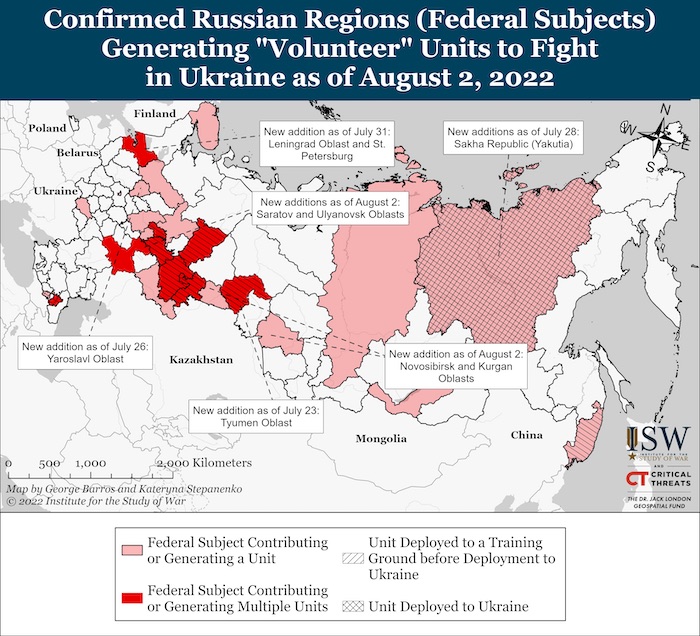
Key Takeaways
- Unconfirmed social media reports suggest that Iran may have sent the first batch of drones to Russia and sent pilots and maintenance personnel to train on the Russian Su-35, potentially suggesting that Iran may seek to use recent aviation agreements to facilitate the acquisition of Russian combat aircraft.
- Russian forces conducted unsuccesful offensive operations northeast and northwest of Kharkiv City.
- Russian forces conducted limited ground attacks northwest of Sloviansk and east of Siversk.
- Russian forces made marginal gains southeast of Bakhmut and continued offensive operations to the northeast and southeast of Bakhmut.
- Russian forces made incremental advances around Avdiivka and are continuing attempts to push southwest of Avdiivka.
- Russian forces launched two assaults in northern Kherson Oblast and are continuing to redeploy troops to the Southern Axis.
- Russian federal subjects are forming new volunteer battalions in Novosibirsk, Saratov, Ulyanovsk, and Kurgan Oblasts, and are changing time periods for enlistment compensations.
- Ukrainian civilians are continuing to resist the Russian occupation with acts of civil disobedience and partisan sabotage as the Kremlin considers longer-term methods of population control in occupied Ukraine.“ (unquote)
The Ukrainian "strategy of corrosion", by the Australian Army Major General (R) Mick Ryan (@WarintheFuture). “Back in May, I examined Ukraine’s military strategy in a thread that I informally called ‘The Ukrainians are Masters of 21st Century War”. Today, an update on the Ukrainian approach - the "strategy of corrosion". It is important we study the Ukrainian military #strategy and how they fight. It offers important insights for the modernisation of western military forces, many of whom remain mired in an intellectual quicksand of Cold War and COIN doctrines.
During their invasion, Russia’s military has been forced by the Ukrainians to continually re-assess its strategic objectives. Russia has downgraded their political goals for Ukraine and the strategy for achieving them. The Ukrainians have fought and subverted the Russian strategy. While political objectives shape how war is conducted and what battles are fought, so too do battles reshape political objectives. It has been the Ukrainian military strategy, implemented with courage and discipline, that has driven this.
The Ukrainians have achieved this through the adoption of a simple military strategy: corrosion. The Ukrainian approach has embraced the corrosion of the Russian physical, moral, and intellectual capacity to fight in Ukraine - and the global information environment. This strategy of corrosion sees Ukraine attacking the Russians where they are weak, while also using some of their combat power to delay and frustrate Russian combat forces. It extends beyond tactics and operations - as I noted before, it also attacks Russian military strategy.
British military historian and theorist, Basil Liddell Hart described this as the indirect approach. He wrote writes how “effective results in war have rarely been attained unless the approach has had such indirectness as to ensure the opponent's unreadiness to meet it.” The Ukrainians have taken this advice to heart. They have attacked the weakest physical support systems of an army in the field – communications networks, logistic supply routes, rear areas, artillery and senior commanders in their command posts.
In the Battles for Kyiv and Kharkiv, the Ukrainians were able to fight the Russians to a standstill because they were able to penetrate Russian rear areas and destroy parts of their logistic support. And in doing so, they had a significant impact on Russian morale. The Ukrainians, therefore, corroded the northern Russian expedition physical and morally from within, and forced its ejection from Ukraine.
The Ukrainians had less success with this approach in the Donbas however. Due to the alignment of the front line, and the concentration of most Russian offensive capacity, the Ukrainians were drawn into an attrition fight there for many weeks. This is a way of war that Russians embrace and one which the Ukrainians would have preferred to avoid. It was a crunching and destructive fight, with many lives spent on both sides for minor tactical gains by the Russians.
The introduction of HIMARS changed this dynamic. It allowed the Ukrainians to realign their defensive operations in the east and adapt to attack the Russian strength (artillery) by targeting its ammunition supply depots. The Ukrainians are re-adopting the asymmetric conventional tactics they used so successfully early in the war. This is the Ukrainian ‘deep battle’, an integral part of their strategy of corrosion.
Another key target is command and control nodes, or in other words, command posts with senior Russian commanders. The ability to rapidly target these & use HIMARS to inflict maximum destruction is vital. Because beyond the physical, there is a psychological impact. Removing headquarters also removes important coordination nodes, breaking down force unity of effort. Targeting soldiers and units degrade (further) their morale and cohesion. Russian morale is being corroded because of its battlefield defeats in the south, declining availability of artillery and destruction (seen on social media) of supply depots. And clever Ukrainian innovations like this are also having an impact.
The use of social media, showing off Russian deficiencies, has magnified this moral corrosion. The corrosion in morale has resulted in declining battlefield discipline, with Russian desertions, battlefield refusals and – horribly – frequent war crimes.
The Ukrainians have also forced on the Russians a deeper form of intellectual corrosion. Under pressure to achieve some form of victory due to previous setbacks, the Russians are taking greater tactical and operational risks with their military operations. More broadly, the Russians are having to form volunteer battalions which will not be as well-equipped, led or trained as the Russian forces that entered Ukraine in February. This is corroding the Russian military and its capacity to sustain operations in the long term.
The Ukrainian consistency in implementing their strategy of corrosion now sees the Russian Army under pressure, with insufficient reinforcements to replace an increasingly exhausted force that is under attack physically and psychologically. Strategically, the Ukrainians are corroding Russia’s international standing with their global influence operations. And they have secured strategic commitments from the EU and NATO.
In corroding the Russian military physically, morally, and intellectually, the Ukrainians have evolved the military art. This is what 21st century war looks like. The Ukrainians have proved to be masters of it.
Ukraine, largely, has refused to fight how Russia wants to fight. It has developed and implemented its own military strategy with great discipline. What might other nations learn from the Ukrainian Armed Forces? In short – a lot.”
Consequences and what to do?
Europe Shouldn’t Let Ukraine Go Into Default, The Washington Post reports. “For six months, the country has been fighting a war on two fronts: repelling the Russian army on the battlefield while countering an economic blitzkrig that is fast degrading its frail economy. The EU pledged to keep Ukraine’s economy afloat in the face of aggression — and it must not allow bureaucratic and political dysfunction to get in the way now.
Alarm bells are ringing over Ukraine’s public finances as the cost of the war grows and fighting prevents Kyiv from maintaining normal commerce. In the past week, Ukraine has had to devalue its currency by 25% against the dollar; it has had to ask foreign creditors for more time to make good on debt payments. The state-controlled energy major, Naftogaz, has missed one already. That has fueled speculation about the condition of the country’s public finances. The collapse of Ukraine’s economy — symbolized by a national default — would hand Russia a huge propaganda victory and cripple morale for Ukrainians. The Kremlin will spin this as a humiliating defeat while arguing that the Russian economy has prevailed despite Western sanctions. It is a scenario that must be avoided.
And that’s exactly what finance ministers of the G-7 agreed to avoid in May when they gathered in Germany for their annual meeting. Indeed, the German finance chief, Christian Lindner, who had assumed the rotating presidency of the group, declared there would be no funding problems for Ukraine as a result of a support package of about 18 billion euros ($18.4 billion), of which, the EU would provide 9 billion.
However, since then, the EU has only authorized the disbursement of a small fraction — with 8 billion euros still to be paid out. The deficit is in limbo because Brussels and EU national governments have yet to settle on how it will be funded. The delay not only risks exacerbating an already difficult situation for Ukraine but also goes against a tacit agreement between Europe and the US in which Americans would provide the bulk of heavy weapons while the Europeans would take care of financial assistance. The EU cannot expect Washington to do the heavy lifting on both. […]
Meanwhile, Ukraine is burning reserves. According to research by Fitch Ratings, Ukraine has been running a monthly deficit of about $4 billion to keep up the war effort, and could see it spiral to 29% of gross domestic product by the end of the year. Fitch alongside S&P Global Ratings have both warned of a default-like scenario for Ukraine.
The severity of the situation should serve as a warning to European authorities dragging their feet over a package that looks like a drop in the ocean against the war’s broader costs. Ukraine’s needs will become more acute the longer the war drags on. Even though Russia seems to have downgraded some of its objectives to focus mostly on the east, Putin shows no intention of wanting anything less than a land grab and Kyiv’s capitulation.
The outlook is further complicated by the fact Europe will soon have an energy crisis unleashed by Putin in retaliation for sanctions. Ukrainians have witnessed such weaponizing first hand with grain. Brussels may have its own set of problems but that does not mean it should drop the ball on Ukraine. Its credibility on the world stage depends on following through. If Europe means business, it must contribute financially to the war effort. If Ukraine loses the economic war, it will lose militarily too. Wars can rarely, if ever, be won on the cheap. The battle for Ukraine is no exception.»



